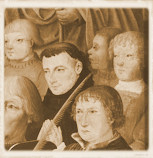
Who doesn’t love a good detective story? In a small exhibition, the Kunsthistorisches Museum takes us on a journey back to 16th century Europe and the mystery surrounding the provenance of two remarkable altar panels.
- Part of the Point of View series
- Explores the likely history of two Dürer-inspired triptych wings
- Runs May 21 – Nov 21, 2021
- Display info in English and German
- See also:
A pioneer of the Dürer revival?

(Monogrammist FH (so-called “Kress Monogrammist”); Two wings with motifs from the Adoration of the Holy Trinity and other works by Dürer; c. 1540/50, inv. GG 930; © KHM-Museumsverband)
Consider two altar panels at the Kunsthistorisches Museum: wings of a triptych from around 1600 (or not, as the case may be).
Then ask who the painter might have been.
Not an easy question to answer as it turns out, and this mystery forms the basis of the 24th iteration of the fascinating Point of View series of mini-exhibitions at the museum.
These exhibitions take a work and dip into the details behind the art, often revealing new research insights and showing us the depth of expertise and analysis involved in the museum world.
A Pioneer of the Dürer Revival or Who was FH? explores the provenance of our two altar paintings and follows a trail through history that ends, sadly, in the unknown.
It all begins back in the 16th century, where Emperor Rudolf II (1552-1612) proved one of history’s great art collectors (though, unfortunately, not one of history’s great emperors). In fact, his acquisitional efforts can still be seen throughout the Kunsthistorisches Museum, most notably in the Kunstkammer.
Rudolf took a shine to the art of Albrecht Dürer (he of Young Hare fame) and had his court artists copy and document the Dürer works assiduously collected for the imperial vaults.
Our two altar panels, for example, certainly seem inspired by Dürer’s Adoration of the Holy Trinity from 1511 (also in the museum) as well as other Dürer works. This led to the assumption that the artist in question belonged to Rudolf’s turn-of-the-century retinue.
Research, however, has brought a different interpretation to light. For example:
- The oak panels actually date back to the 1540s, a few decades before Rudolf acquired Dürer’s version
- A painting with an identical theme found in a US museum bears the hallmarks of the same artist and a similar earlier date
- The artist’s monogram, though indistinct, matches the FH monogram on a landscape drawing at Vienna’s Albertina museum
Researchers pieced the evidence together with stylistic and material analysis to suggest common authorship of the above works some years before the era (the “Dürer Renaissance”) normally associated with renewed interest in Dürer’s work. (And well before our assumed date of origin for the panels.)
Combining the above analysis with what we know of the geography and history of the works that inspired the panels indicates that the artist, who remains anonymous, may well have left Nuremberg (once site of Dürer’s workshop) for the Netherlands, where he produced our panels.
The rest of the details I leave for you to discover in the museum…the research story is fascinating.
The moral of the exhibition? A picture may indeed tell a tale, but not necessarily the one we thought we knew.
Dates and tickets
Explore the mysteries of the altar panels from May 21st to November 21st, 2021. A normal entrance ticket for the museum includes access to the mini exhibition.
Incidentally, the start and end of Who was FH? coincide with two major exhibitions at the Kunsthistorisches Museum:
- Higher Powers (until August 15th, 2021)
- Titian’s Vision of Women (provisionally from October 5th, 2021)
(Check locally for entry requirements; both major exhibitions may require a special ticket.)
How to get to the exhibition
Follow the travel tips for the museum on the main page, then find your way up to the picture galleries. Look for the small room (Kabinett 16) off gallery XI.
Address: Burgring 7, 1010 Vienna